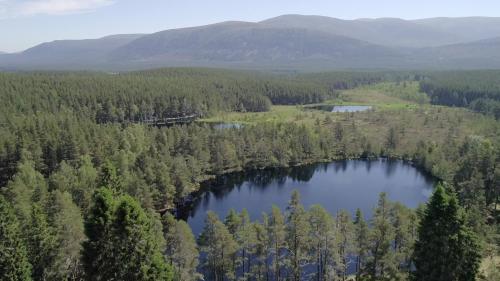Nature-based Solutions (NbS) have been defined many times, but these definitions can be summarised as “solutions to societal challenges that are inspired and supported by nature”. Examples would be the restoration of peat bogs to return them to net sinks of carbon dioxide from the atmosphere or re-meandering rivers to reduce flood risk. However, not all NbS are equal: the term can be applied to different interventions in quite varied settings, tackling varied problems. There is a need to evaluate and understand NbS, to help understand the potential of alternative approaches, and how best to allocate resources amongst a choice of different NbS. To do this an assessment framework is needed to facilitate development, allow later evaluation and to compare efforts.
This SEFARI Fellowship project was co-developed with NatureScot to identify a suitable framework for Scotland’s terrestrial landscapes from those already developed. Each framework had its own strengths and weaknesses. Our recommendation is to focus on using the IUCN Global Standard. This is a comprehensive method supported by a significant international institution and it is likely to be widely employed. However, other frameworks performed better in some areas, so we propose that guidance is developed for the use of the IUCN standard which enables users to reinforce its approach with the strengths of other frameworks.

Stage
Directory of Expertise
Purpose
A wide range of frameworks are available to either assess the benefits of NbS in the development phase or to assess their effectiveness (Cohen-Shacham et al. 2019). These have been developed by international teams led by academics and professionals, e.g., from conservation, or planning, rather than being specific to Scotland. We were therefore asked by NatureScot to identify the most appropriate framework for use by a wide range of organisations in Scotland. The aims of using such a framework are to guide planning, assist evaluation and encourage standardisation, so allowing a body of expertise to build up in the use of this framework.
We used a two-stage evaluation process. Firstly, we identified a long list of potential frameworks to evaluate. An initial set of questions was applied separately by the three team members from different disciplinary backgrounds to this long list: those that appeared to be adaptable to different settings and covered a wide range of benefits/disbenefits went forward to full evaluation.
In the second stage of evaluation, the short-listed frameworks were subject to a detailed appraisal, using 15 questions or criteria (many of which had sub-questions). Questions included: comprehensiveness of coverage of biophysical and socio-economic benefits, the involvement of stakeholders, and practicality of use. Using these evaluations, we identified the framework most suitable for use by NatureScot and other organisations, as well as recommendations for future work to develop guidance and key knowledge gaps.
The results of the second stage of evaluation and our other findings were presented at a workshop with key stakeholders. A range of issues were identified and included in the final report.
Results
Of the 23 frameworks, six were unanimously supported through to the second stage:
- Ecosystem Approach
- EKLIPSE
- ENCA - Enabling a Natural Capital Approach
- Interreg Building with Nature
- IUCN (International Union for Conservation of Nature) Global Standard for NbS
- ThinkNature Handbook.
A seventh framework was added, Revaluation, as it was radically different in approach – this methodology is designed for any complex system or process rather than specifically for NbS.
The final decision was to recommend the IUCN Global Standard for NbS for adoption alongside its self-assessment tool. As well as addressing many of the requirements of an effective framework for assessing NbS, it emphasises the need for multi-functional NbS that support and ideally enhance biodiversity. It also has the added benefits of the support of an international institution and likely wide take-up, resulting in building a wide body of expertise and the potential for easy synthesis across many case studies.
However, we acknowledged that some other frameworks have strengths in certain areas. The ThinkNature handbook provides a better introduction to NbS and would be worth reading before attempting the detail of planning or assessing a NbS. We also suggest that the simple scoring approach of the Interreg Building with Nature framework be made available in situations where detailed valuation of benefits and disbenefits is outside the skills of those managing the NbS (Huthoff et al. 2018). Also, consideration of how social benefits are assessed, as per EKLIPSE and its challenges 7 “Participatory planning and governance”, 8 “Social justice and social cohesion” and 9 “Public health and wellbeing”, would strengthen any NbS. Finally, ENCA provides useful valuation data and approaches to quantify natural assets and services.

Navigating Your Route to Nature-based Solutions: the eight criteria which need to be met during both planning and evaluation of NbS. A summary note introduces these criteria to encourage application in Scotland and provides links to further explanation and guidance.
Benefits
The adoption of a single framework by many organisations across Scotland will help build up expertise, enable comparison of different solutions and facilitate wider analysis of the benefits of NbS. We propose that further work be carried out to assess if the IUCN standard is appropriate for marine systems, and to develop guidance on embedding the IUCN Global Standard for NbS planning and assessment in Scotland: incorporating the strengths of other frameworks, information sources on valuation and, potentially, develop versions of the guidance for different stakeholders. Later developments could include the publication of example assessments, to provide a template for others to follow in embedding NbS in future thinking in different scales and settings and developing the guidance to enable funding/investment decisions to be made by actors beyond the ‘usual’ eNGO and public agencies.
Project Partners
NatureScot